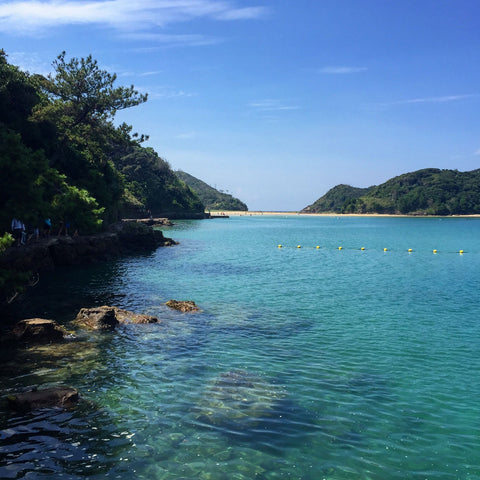 Sake Gumi is our monthly sake subscription service with 250 members throughout the country. Join today!
Sake Gumi is our monthly sake subscription service with 250 members throughout the country. Join today!
In the seven years that we've been running the Sakqueso theme, we've introduced novel ideas (fresh mozzarella drizzled with shoyu and wasabi in 2020), and thrown lavish dinners with our favorite food professionals (Casa de Kei and Tim Sullivan teamed up for a three-course menu at Sequoia Diner in 2016). I look forward to June every year because I get to explore this delectable theme and plan recipes and events to complement it.
Sake and cheese work so well together mainly because they share a common ingredient during fermentation: lactic acid. In addition to creating an environment where unwanted microorganisms cease multiplying, lactic acid results in flavors high in umami. And having sake and cheese, which are both high in umami, creates an umami explosion – often leading one to discover a third flavor that would only be unlocked when having them together. Kimotos and yamahais have particularly pronounced umami because the shubo (starter) method involves naturally occurring lactic acid that is often more sturdy and robust. So it's not a coincidence that half of sakes for this month are yamahais.
I appreciate the link that Keisuke Kawana, the head of the Manufacturing Department at Tatenokawa Brewery makes between sake and cheese, "There are many brewed liquors in the world that pair well with cheese, such as wine and beer, but sake is by far the best of them all. Sake has the highest amino acid content of all of them. I think it is no overstatement to say that sake is the best liquor in the world for cheese."
This year, we are so excited to be back for an in-person Sakqueso event on June 23 at 5:30pm! Join us for Sakqueso: Pairing Sake + Cheese with Kevin Corcoran CCP (Certified Cheese Professional), an intimate tasting of four sakes with four cheeses at the Umami Mart Bar. If you can't join us for the event, we'll be sure to publish the pairings on our blog so you can have your own Sakqueso at home!
Additionally, please find cheese pairings from the brewers on the reverse side of these notes. We are especially excited about the recipe for iburi-gakko (smoked takuan pickles) and cream cheese and hope you try it at home!
Yoko, Co-Founder of Umami Mart and Kikizakeshi
+++
 Kiminoi “Emperors Well” Yamahai Junmai Ginjo
Kiminoi “Emperors Well” Yamahai Junmai Ginjo
Kiminoi Shuzo (Niigata, Japan)
Seimaibuai: 55% Gohyaku Mangoku, SMV: +0, Acidity: 1.3
"This sake is ideal for pairing with cheese because it is a yamahai, a brewing method that cultivates lactic acid bacteria," says Shimotori-san of Kiminoi Brewery. Try this sake lukewarm and notice aromas of mochi and banana and its slightly acidic finish. Shimotori-san also encourages members to try wafu (Japanese style) cheese by having slices of fresh mozzarella with green onions and katsuobushi (bonito flakes) or with soy sauce. Umami overload?! Never.
 Mantensei “Star-Filled Sky” Junmai Ginjo
Mantensei “Star-Filled Sky” Junmai Ginjo
Suwa Shuzo (Tottori, Japan)
Seimaibuai: 50% Tamasakae + Kojima, SMV: +5, Acidity: 1.4
Lover of mycology and cheese, brewery director Touda-san encourages members to warm this 3-year aged sake up to 130°F with your cheese pairing. "I usually get mimolette, gouda, camembert, brie, gorgonzola and époisses and let the umami from the cheese spread in the mouth as you sip the warm sake." He also recommends spreading brie on slices of iburi gakko (smoked daikon pickles).” We specifically liked this sake at room temperature with notes of cedar, honey, and raisin, with the tart and salty Castelrosso (Toma Brusca) cow’s milk cheese.
 Tatenyan Junmai Daiginjo
Tatenyan Junmai Daiginjo
Tatenokawa Shuzo (Yamagata, Japan)
Seimaibuai: 50% Miyama Nishiki, SMV: +2, Acidity: 1.6
 Minato “Harbor” Tsuchizaki Yamahai Nama Genshu
Minato “Harbor” Tsuchizaki Yamahai Nama Genshu
Naba Shoten Brewery (Akita, Japan)
Seimaibuai: 67% Akita Komachi, SMV: +1, Acidity: 1.7
When asked about the packaging, Naoshi Naba CEO of Naba Shoten replied, "We wanted to convey that this sake is being carried directly from the storage tank to the mouth of the bottle, without modification after brewing. The aluminum can resembles a storage tank." At 20% ABV it’s ideal chilled or on-the-rocks. The fact that it’s a nama (unpasteurized) gives it a sweet, weighty texture with aromas of toasted coconut and mushrooms. We loved this sake with cream cheese with iburi-gakko.




Comments (0)
There are no comments for this article. Be the first one to leave a message!